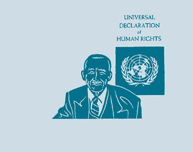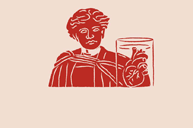IDEAS THAT MADE HISTORY
How McGill minds and their "Eureka!" moments helped change the world
Your idea of a quintessential McGill moment might be cramming for exams in the McLennan library. Or soaking up some spring sun on the steps of the Arts Building. Or indulging in an all-night bull session with your best buddies in res (when you should have been cramming for exams). But how about this one: Safe behind the hockey rink's Plexiglas barrier, you rise for the national anthem, then snap a quick digital photo of the puck drop—all while munching on a fish stick.
Believe it or not, it might not get more "McGill" than that.
The McGill brain trust—a crackling network of professors and students, past and present—doesn't just span the world, it changes it. In the following pages, you'll learn about the 40 ways the University's brightest minds have shaped your life, from sports to medicine to—yes—fish sticks, Plexiglas, "O Canada," photo technology and hockey.
BY DANIEL MCCABE, BA'89, MARK REYNOLDS, JAMES MARTIN, MLIS'05, AND MAEVE
HALDANE
ILLUSTRATIONS BY TZIGANE
TRADUCTION DE LUCIE LEGAULT
IDÉES PASSÉES À L'HISTOIRE
Comment les grands esprits de McGill ont, dans leurs moments de génie, contribué à changer le monde
Quand vous songez à des moments qui expriment la quintessence de votre vécu à McGill, vous vous revoyez peut-être en train de préparer vos examens à la bibliothèque McLennan. Ou de lancer un frisbee sur le campus inférieur. Ou encore de suivre vos premiers cours dans un amphithéâtre bondé du pavillon Leacock. Toutefois, les moments dont McGill est le pivot ne se limitent pas au temps que vous avez passé sur le campus. De fait, vous en vivez plusieurs fois par jour. C'est simplement que vous l'ignoriez.
Jusqu'à maintenant.
Le fait est que non seulement le réseau des grands esprits de McGill—formé de brillants professeurs et étudiants, d'hier et d'aujourd'hui—étend ses ramifications partout dans le monde, mais qu'il contribue en outre à le changer. Dans les pages qui suivent, vous découvrirez les 40 innovations grâce auxquelles les plus brillants esprits de l'Université ont modelé votre vie, dans le domaine des sports comme de la médecine, du divertissement comme de l'alimentation.

1. It's a sport regularly played by millions around the world, but James Naismith's aspirations were modest when he invented basketball. His principal goals in devising the sport in 1891 were simply to "make it fair for all players and free of rough play." Naismith, BA1887, LD'38, noted that athletes tended to get banged up and battered close to where the scoring took place—a goal line or a net. So he put the scoring area for his new sport high out of reach—a peach basket hanging 10 feet up.
2. While director of McGill's Social Science Research Group throughout the thirties, Leonard Marsh studied the effects of the Depression on the lives of ordinary Canadians—and concluded that Canada needed a "social minimum" to buffer the disadvantaged from undue hardship. He carried this resolve with him when he left McGill, serving as the chief author of the 1943 Report on Social Security for Canada, which called for old-age pensions, employment insurance, child benefits and income supplements. Policymakers were slow to heed Marsh, but by 1966 most of his recommendations had become law. University of Toronto historian Michael Bliss described the report as "the most important single document in the history of the welfare state in Canada." Marsh himself viewed his report as the natural outgrowth of the decade of social studies he directed at McGill.
3. Robert Stanley Weir, BCL1880, DCL1897, was an accomplished teacher, lawyer and judge, and his poetry was good enough to earn him membershipin the Royal Society of Canada. But that's not what we remember him for. We remember him for "O Canada." When the original French version of the song, composed in 1880, became hugely popular, scores of would-be songwriters took a stab at writing an English version. The one that won widespread public acceptance was penned by Weir in 1908. By the time the First World War erupted, his version of "O Canada" was the best-known patriotic song in the country—and it only took the federal government until 1980 to adopt it (with slight modification) as Canada's national anthem.
4. Au début des années quarante, à l'époque où Harold Randall Griffith (B.A. 1914, MDCM 1922) était anesthésiste en chef à l'Hôpital homéopathique de Montréal, anesthésier un patient nécessitait l'utilisation de l'éther ou d'autres gaz, ce qui donnait lieu, dans le meilleur des cas, à une convalescence des plus pénibles et qui, dans le pire, entraînait la mort. Le médecin constata par la suite que l'utilisation de petites quantités d'un extrait d'une plante toxique—un poison utilisé par les chasseurs indigènes d'Amérique du Sud qui en enduisaient l'extrémité des fléchettes projetées par leurs sarbacanes—permettait de limiter les convulsions. En 1942, il devint la première personne à utiliser le curare à titre d'agent anesthétique chirurgical. Griffith prouva que l'administration prudente du curare parvenait à détendre le corps d'une manière exceptionnelle et sécuritaire. L'emploi du curare a ouvert la voie au développement de dizaines de médicaments similaires encore largement utilisés dans les salles d'opération.
5. When it comes to DNA, Watson and Crick tend to get all the attention (not to mention the Nobel Prize) for determining its structure, but it was another team of scientists, one which included Colin Munro MacLeod, MDCM'32, that first identified DNA as the building blocks of genetics in the early forties. MacLeod would go on to serve as a senior science advisor to U.S. presidents John F. Kennedy and Lyndon Johnson.
6. During the thirties, Columbia University psychology professor Otto Klineberg, BA'19, MDCM'25, DSc'69, examined the IQ scores of black and white children in the U.S. segregated South and the desegregated North. His key finding: Southern black children's IQ averages, the lowest of all the groups, rocketed when they began attending desegregated schools. Klineberg's work played a crucial role in the landmark 1954 U.S. Supreme Court case that led to the desegregation of Southern schools.
7. What Canadian city is the birthplace of hockey? That's an argument best left for the nation's barrooms. But we do know that the first game of organized indoor hockey took place on March 3, 1875, at the Victoria Skating Rink in downtown Montreal. Civil engineer James Creighton, BCL1880, organized the game, and many of the players who took part were McGill students. Creighton thought the nascent sport would draw better crowds than lacrosse (he was right). The world's first official hockey team, the McGill Hockey Club, made its debut two years later and some of the players—Richard F. Smith, BSc1883, W. F. Robertson, BSc1880, and W. L. Murray—helped refine the rules, including the introduction of a rubber puck, carved out of a lacrosse ball. Two enterprising brothers who skated together on a championship-winning McGill hockey team two decades later shaped hockey into the sport we know today. Frank Patrick, BA1908, and Lester Patrick (he dropped out of McGill to play professionally) created the Pacific Coast Hockey Association in 1911. The PCHA rivaled the National Hockey Association (soon to be the National Hockey League), thanks in large part to the Patricks' innovations: Canada's first artificial ice hockey rinks, penalty shots, numbered jerseys, "on-the-fly" line changes, assists and the blue line. The brothers sold their league (and its rules) to the NHL in 1926, and both men were inducted into the Hockey Hall of Fame.
8. Les pionniers de la médecine, dont Wilder Penfield de l'Institut neurologique de Montréal (INM), se passent de présentation. Pourtant, leurs réussites n'auraient pas été possibles sans la contribution d'ingénieurs de talent qui ont mis au point les instruments dont les chercheurs avaient besoin. Leon Katz (B. Ing. 1950) est l'un d'eux. Pendant deux ans, l'ingénieur a travaillé aux côtés du docteur Penfield à l'INM avant de se joindre à l'Hôpital général juif de Montréal, où il a créé le premier laboratoire de radioisotopes médicaux au Canada. Il a contribué à développer l'utilisation de l'iode radioactif dans la cartographie thyroïdienne, une technique diagnostique maintenant largement répandue. Officier de l'Ordre du Canada, Leon Katz a conçu et a fait fonctionner le courpoumon artificiel utilisé lors de la première chirurgie à cour ouvert réussie au Canada en 1957. Après avoir inventé une vaste gamme d'appareils médicaux, Leon Katz est entré au service de Santé et Bien-être social Canada où il a contribué à l'établissement de règlements de sécurité applicables à l'équipement médical.
9. As the co-founder of Montreal's Just For Laughs International Comedy Festival, Andy Nulman, BCom'83, played a leading role in transforming a modest two-day event into an unparalleled showcase for comedic talent from around the world. The annual festival attracts battalions of Hollywood talent scouts, all eager to spot the next big thing. Rowan Atkinson first introduced "Mr. Bean" to audiences at the festival, while Tim Allen and Kevin James are among those who've parlayed breakthrough performances at the festival into sitcom deals with major U.S. networks.

10. Harry Potter may be read in over 60 languages but John Humphrey's words have been translated into 300 languages and dialects. In fact, Humphrey, BCom'25, BA'27, BCL'29, PhD'45, LLD'76, prepared the first draft of the world's most translated text—and one of its most important: the Universal Declaration of Human Rights. In 1946, United Nations Assistant Secretary-General Henri Lauger appointed Humphrey as the director of the UN's Human Rights Division. In that role, Humphrey worked closely with the UN's Human Rights Commission (and its high-powered chair, Eleanor Roosevelt) in creating the Declaration. Humphrey returned to McGill in 1966, where he remained an outspoken advocate for human rights until his death in 1995.
11. Avant Hans Selye (D. Sc. 1942), le stress avait trait à la pression exercée sur un objet, et non sur un individu. En 1934, le jeune endocrinologue mcgillois a constaté certaines similarités dans la façon dont le rat réagit aux injections, malgré une différence à l'égard des composés chimiques. Le chercheur en a conclu qu'il existe une réponse biologique au stress. En 1936, il a publié des données novatrices qui posent comme postulat que le corps humain réagit au stress en étapes. La première est une phase d'alarme, où le corps s'efforce de combattre la source du stress. Vient ensuite une phase où il cherche à s'y adapter. Finalement, le stress produit un effet d'usure qui endommage l'organisme. L'influence de Selye a dépassé les cercles médicaux puisque deux de ses ouvrages, Le stress de la vie et Le stress sans détresse, sont devenus des succès de librairie internationaux.

12. Newfoundland doctor Cluny MacPherson, MDCM1901, was serving overseas in the First World War, as an advisor on withstanding poisonous gas attacks, when he modified a captured German helmet, fashioning a canvas hood outfitted with transparent eyepieces and treated with toxin-neutralizing chemicals. His invention, the gas mask, would be used by soldiers around the world to protect themselves from a particularly grisly form of death on the battlefield.
13. When Charles Drew, MDCM'33, began his fateful research into the properties of blood, the subject of his work could only be safely stored for about a week before it began to spoil. Drew focused his efforts on blood plasma, which he determined could be used safely as a substitute for whole blood. After developing a safe and highly sterile system for preserving large quantities of blood plasma, Drew put his techniques to the test as the medical supervisor for the Blood for Britain campaign during the Second World War, overseeing a fleet of refrigerated "bloodmobiles" that delivered plasma to wounded soldiers and civilians as Nazi warplanes rained bombs throughout England. Following the war, the Red Cross tapped Drew to lead its budding blood bank program.
14. While aspects of their revolutionary theory still spur debate between scientists, nobody disputes that Ronald Melzack, BSc'50, MSc'51, PhD'54, and Patrick Wall changed the way we all think about pain. In their seminal 1965 paper, the duo presented the Gate Control Theory of Pain: Rather than traveling straight to the brain, they argued, pain signals are modulated by other sensory inputs. Melzack, an emeritus professor of psychology at the University, also developed the McGill Pain Questionnaire, now used throughout the world. This stemmed from Melzack's realization that patients in pain often had a hard time putting what they were going through into words. So he made the process easier for them, offering over 100 descriptions such as "shooting," "stabbing" and "creeping" to choose from. The distinctions are important because they help physicians make more accurate diagnoses.
15. In 1965, McGill professor Samuel Freedman, BSc'48, MDCM'53, DipIntMed'58, DSc'92, and doctoral candidate Phil Gold, BSc'57, MDCM'61, MSc'61, PhD'65, discovered a protein they called carcinoembryonic antigen. The body produces CEA in response to certain cancers (particularly those in the gastrointestinal tract, colon and rectum), making the protein's presence a useful tumour marker. The CEA blood test remains one of the most widely used methods for gauging the spread of cancer and detecting post-surgery recurrence.
16. It might be the most memorable research project of Brenda Milner's illustrious career, but the man she studied for three decades couldn't remember her from one visit to the next. The fellow, a severe epileptic known as H.M., underwent brain surgery which left him unable to transform short-term memories into long-term memory. But Milner, PhD'52, DSc'91, noticed that H.M. could still develop new skills through practice—even though he couldn't remember practising. Through her work with H.M. in the fifties, Milner revolutionized cognitive neuroscience by proving the human brain has more than one system for governing memory. The octogenarian H.M. still participates in memory studies and Milner, now in her 90s, is McGill's Dorothy J. Killam Professor of Neurology and Neurosurgery and an active researcher at the Montreal Neurological Institute.
17. David Hubel, BSc'47, MDCM'51, DSc'78, earned the 1981 Nobel Prize in Medicine for providing invaluable insights into the workings of sight. Working with Torsten Wiesel in the sixties, Hubel demonstrated how the visual cortex functioned, noting that a network of nerve cells play crucial and different roles in interpreting the information we receive through vision—some are specifically geared to detect movement, others are designed to focus on colours, form or depth.
18. C'est l'ennui qui a amené Roger Daley (M. Sc. 1966, Ph. D. 1968) à marquer l'Histoire. En 1966, il était employé par les Services météorologiques canadiens à la base de l'Armée de l'air des États-Unis à Goose Bay, au Labrador. Pour passer le temps, il demanda aux pilotes de noter certains éléments météorologiques dont la température et la direction éolienne lors de passages turbulents. À partir des données ainsi recueillies, Daley tenta de prédire la turbulence et c'est alors que prit naissance la quête de sa vie : les systèmes de prévision météorologique numérique. Selon Barry Shell, auteur de Scientifiques sensationnels, les techniques de Daley « forment la base de presque tous les systèmes de prévision et de simulation climatique à long terme utilisés dans le monde ».
19. In 1956, Thomas Chang, BSc'57, MD'61, PhD'65, a McGill undergraduate studying physiology, transformed his Douglas Hall residence room into a makeshift laboratory and went about constructing the world's first artificial blood cells. Blessed with good-natured roommates and equipped with a cheap perfume atomizer, the young scientist managed to construct tiny plastic membranes that could contain hemoglobin, the compound in red blood cells that transports oxygen and whisks away carbon dioxide. His success (he was the rare undergrad to publish a paper in Science, one of the world's most prestigious journals) helped spawn the realm of biotechnology.

20. A daring and gifted surgeon (and the driving force behind the creation of the Montreal Neurological Institute), Wilder Penfield developed the Montreal Procedure in the thirties to treat severe cases of epilepsy. This was a new kind of brain surgery: Patients remained fully conscious (though anesthetized) while Penfield used mild electric shocks to pinpoint which parts of the brain caused the seizures. Using this method, he noticed how different areas of the brain, when stimulated, resulted in his patients re-experiencing old memories. Or colours. Or sounds. Penfield began mapping brain functions, a pioneering effort that blazed a trail for generations of scientists since.
21. Parents of finicky little eaters the world over owe William Forsey Hampton, PhD'33, a thank you. After his doctoral studies in chemistry at McGill, Hampton returned home to Newfoundland, where he became the director of research development for the General Seafoods fisheries laboratory. In the fifties, the spread of TV led to a demand for quick and easy meals, and Hampton saw a way to boost the fish business. Voila: the precooked fish stick. Pop in the oven, and it was ready by the next set of commercials.
22. Leslie Geddes (B. Ing. 1945, M. Ing. 1953, D. Sc. 1971) a fait de grandes choses, en toutes petites dimensions. Professeur de génie biomédical à l'Université Purdue, il a créé avec son équipe de minuscules appareils biomédicaux dont un moniteur miniature de signes vitaux pour les nourrissons prématurés ainsi qu'un défibrillateur automatisé miniature suffisamment petit pour être implanté chez les patients atteints d'une cardiopathie. Ce dernier envoie vers le cour des décharges électriques qui neutralisent la crise cardiaque. M. Geddes a également inventé un électrocardiographe portable que les patients peuvent utiliser pour surveiller le schéma électrique cardiaque. En juillet 2007, Geddes a reçu des mains du président George W. Bush la Médaille nationale de technologie des États-Unis.

23. When Maude Abbott first joined McGill's Department of Pathology as the assistant curator of McGill's medical museum, little was known about how to surgically repair damaged hearts. Through her work at the museum, Abbott collected and studied the hearts of people who had died of cardiac problems. She also scoured historical records for accounts of heart disease, meticulously cataloguing and identifying cardiac anomalies identified during autopsies. The result was the 1936 Atlas of Congenital Cardiac Disease, which laid the foundation for modern heart surgery by giving physicians a detailed understanding of the anatomy of heart disease.
24. The next time you plot your vacation route on the web, stop to thank the elephants. And the monkeys. In the sixties, Roger Tomlinson, MSc'61, DSc'06, was plotting out locations to plant trees for a paper mill in Kenya. He needed to factor in monkey populations and elephant migration routes, topography, soil types and rainfall. To do this work manually would be prohibitively expensive—but computers, he mused, might speed things up. A few years later, Tomlinson convinced the Canadian government to use his new method to digitally map the country, creating overlays to show population, forests and potential farmland. The resulting technology, Geographic Information System (GIS), now drives Google Maps, MapQuest and countless other applications.
25. En 1969, alors à l'emploi des célèbres Laboratoires Bell, au New Jersey, Willard Boyle (B. Sc. 1947, M. Sc. 1948, Ph. D. 1950) a inventé, avec un autre chercheur, le dispositif à couplage de charge, une puce photosensible qui est désormais un composant essentiel d'une multitude d'outils dont les caméras numériques, les lecteurs optiques et le télescope spatial Hubble. Boyle a également inventé le laser à rubis, qui est largement utilisé pour faire disparaître les tatouages. C'est donc lui que l'on doit remercier lorsqu'on veut immortaliser de précieux souvenirs… et en effacer de mauvais.
26. Airports around the world use the explosives vapour detector (EVD-1) invented by Lorne Elias, PhD'56, to guard against terrorist attacks. Elias originally developed the technology to seek out pesticide vapours, but in the wake of terrorist bomb threats and hijackings during the seventies, Canadian aviation security officials approached his National Research Council team to see if the technology could also sniff out chemical particles in hidden bombs. The use of the EVD-1 became standard in Canadian airports following the 1985 Air India bombing. Elias and his team also created ion mobility spectrometry, which can detect electrically charged particles associated with explosives.
27. Bernard Belleau, PhD'50, saved millions of lives and never knew it. In the eighties, AZT was the only option for suppressing HIV, but the drug had a dark side: patients not only suffered debilitating side effects, they quickly grew immune to its anti-HIV properties. So the McGill chemistry professor went hunting for an alternative. Belleau led the charge to synthesize 3TC, a compound which stunts HIV's tenacious rate of replication—without the drawbacks of AZT. Belleau died in 1989, six years before the last stage of 3TC clinical trials ended. The drug proved a turning point in developing the HIV-fighting "cocktail" that helped curb the AIDS mortality rate. "There's no question that this drug is the most important medical achievement in Canada since the discovery of insulin in 1921," Mark Wainberg, BSc'66, director of the McGill University AIDS Centre, told the Globe and Mail. "Bernard Belleau is a true Canadian genius, who never received the credit he was due."
28. In 1911, German scientist Otto Röhm invented a resilient, flexible and transparent substance. Trouble was, it was hard to find one key ingredient: methyl methacrylate. Enter William Chalmers, PhD'30, a McGill graduate student working in chemistry professor George Whitby's lab. Chalmers devised a new method for producing methyl methacrylate using acetone and hydrogen cyanide, both readily available. Knowing that Imperial Chemical Industries in Britain was doing similar work, Chalmers sold them his patent. One of the first commercial uses for ICI's Perspex—now known as Plexiglas—was to make see-through machine gun turrets for B-19 bombers. Today, Plexiglas is used in hockey rinks (the transparent barriers protecting onlookers from misdirected pucks), aquariums, contact lenses and motorcycle helmets.
29. In a 1901 lecture, McGill physics professor Ernest Rutherford presented a startling theory —namely, that radioactivity was the product of fracturing atoms—and was duly heckled by a young researcher from the Department of Chemistry. It wasn't a promising start, but within months that skeptic, Frederick Soddy, became Rutherford's chief collaborator in a research effort that led to both men winning the Nobel Prize (Rutherford in 1908, Soddy in 1921). Flying in the face of the widespread belief that atoms were indivisible and unchangeable, the duo demonstrated that atoms could spontaneously decay, forming new kinds of matter as a consequence. Though many scientific contemporaries initially scorned the notion as alchemy, Rutherford's theories quickly gained wide acceptance and he is universally recognized today as the father of nuclear physics.
30. S'il est vrai que l'ADN a ouvert la voie à la biologie et à la médecine modernes, il est également juste d'affirmer que Kelvin Ogilvie est le Henry Ford de notre ère. En 1980, alors professeur de chimie à McGill, il a accéléré le processus d'épissage de l'ADN en inventant une « machine génétique », transformant la durée de cette démarche de plusieurs jours en quelques heures et ouvrant ainsi la voie à une multitude de possibilités, notamment à l'égard de cultures génétiquement modifiées et de la recherche médicale. En 1986, Ogilvie fut le premier à mettre au point une méthode de synthèse chimique de molécules d'ARN, un procédé qui fut par la suite utilisé pour développer le Ganciclovir, un médicament désormais utilisé dans le traitement d'une forme d'herpès qui s'attaque aux sujets dont le système immunitaire est affaibli, comme les personnes atteintes du sida ou du cancer.
31. Canadian literature wasn't exactly the sexiest thing going until Jack Rabinovitch, BA'52, DLitt'05, came along. In 1994, Rabinovitch paid tribute to his late wife, literary journalist Doris Giller, by creating a new book prize for works of fiction. With a plump prize purse ($40,000 for first place) distributed during a glitzy black tie ceremony, the Scotiabank Giller Prize has become, in the estimation of veteran critic Robert Fulford, "the most celebrated arts prize in the country." A powerful rivalry has developed between the Giller and the Governor General's Literary Award—many an argument has been sparked each year about which award had the more deserving winner. The real winners, thanks to the considerable attention the Giller garners, are Canadian writers.
32. While working as a McGill system administrator, Alan Emtage, BSc'87, MSc'91, was tasked with trolling the nascent Internet for free software. So, like any self-respecting geek, he wrote an open-source program to do the work for him. And so was born Archie, the first Internet search engine. Archie did more than just lighten Emtage's load; until the mid-nineties, the non-proprietary system attracted half the web traffic in Canada. But Emtage makes no claim for setting the precedent for goofy search engine monikers (see also: Yahoo!, Google), insisting Archie is a diminutive of "archive," not an homage to the red-headed comic book teen.

33, 34, 35. The Academy of Motion Picture Arts and Sciences Scientific and Technical Achievement Awards may command less attention (and feature less cleavage) than their glittery sibling, but the achievements they honour are no less impressive. The National Film Board's Frederick Gasoi, BEng'67, won his Oscar in 1998 for creating, with collaborators from the National Film Board (NFB) and Research in Motion, the DigiSync Film KeyKode reader. The reader decodes data stored on the edge of film stock, allowing editors to more efficiently navigate reams of footage. Without Demetri Terzopoulos, BEng'78, MEng'80, animated cinematic emperors would have no clothes—or at least, not very realistic ones. Terzopoulos won an Oscar in 2006 for his work on a computer animation technique that makes fake fabric billow and blow convincingly. His technology has appeared in the recent Star Wars and Lord of the Rings films. Another Oscar-winning McGill grad whose technical wizardry dazzled the masses is Marceli Wein, BEng'58, MEng'61, PhD'64. Working with NFB colleague Nestor Burtnyk, Wein helped develop computer-assisted key framing software, which allows artists to draw only the "key frames," letting a computer fill in the laborious gaps. "Hunger," a 1974 short, became the first computer-animated film to be nominated for an Oscar, and bears the fruit of this technique—recognized as the cornerstone of Canada's multi-million-dollar computer animation industry.

36. John Andrew Macphail (MDCM 1891) a été le premier professeur d'histoire de la médecine de McGill. Il a d'ailleurs lui-même écrit une page de cette histoire en devenant, en 1911, le rédacteur en chef et fondateur du Journal de l'Association médicale canadienne, l'une des publications médicales les plus anciennes et les plus réputées au monde. Le JAMC a été le premier à publier les résultats des travaux de Frederick Banting et de son équipe, lesquels ont mené à la découverte de l'insuline et ont été couronnés du prix Nobel. Le Journal se classe parmi les dix principaux journaux médicaux généraux, groupe prestigieux qui inclut le British Medical Journal et le Journal of the American Medical Association.
37. It's rude, crude and full of attitude. It's been called the "hipster's Bible" and, along with the likes of South Park, it's had a profound effect on youth culture, challenging Baby Boomer conventions with irreverence and a marked lack of respect. Philosophy graduate Suroosh Alvi, BA'91, co-created Vice magazine in 1994 and the magazine has since grown into a multimedia "empire of hedonism," spawning a record label, a clothing line, a TV station and films and books (not to mention a bunch of copycat publications). "Vice was a Playboy for the turn of the millennium," raves McGill communications professor Will Straw, "ostensibly about music and other stuff, but really about being a man."
38. En 1937, alors que la guerre menaçait d'éclater, Lloyd Pidgeon, un scientifique de renom du Conseil national de recherches, a entrepris l'ambitieuse tâche de réinventer la production de magnésium. Difficile à fabriquer, ce métal léger et durable était essentiel à la construction d'avions. Lloyd Pidgeon (M. Sc. 1927, Ph. D. 1929) a imaginé un procédé à la fois plus simple, plus rapide et moins coûteux, à la suite de quoi six usines de production furent rapidement construites dans le but de tabler sur cette innovation. En 1942, la découverte du chercheur a été officiellement saluée comme « un procédé de la plus grande importance dans le cadre de l'effort de guerre industriel mené par les Forces Alliées », ce qui lui valu d'être fait membre de l'Ordre de l'Empire britannique. Le procédé élaboré par Lloyd Pidgeon repose sur l'alliage de l'aluminium et du magnésium, lequel demeure largement utilisé de nos jours—notamment dans la fabrication de canettes.
39. Eric Callen got used to being the butt of jokes. In 1955, the McGill plant pathologist developed a technique for reconstituting hardened fossilized feces by soaking it in trisodium phosphate. Callen was looking for maize pathogens, but instead found rich information on what ancient peoples ate, their state of health and their environment. Inspired, he switched fields to archaeology. Initially considered frivolous by his colleagues, human coprolite analysis is now widely used to uncover information about the past. The previously obscure scientist was recently immortalized in the children's book Jurassic Poop: What Dinosaurs (And Others) Left Behind.
40. Pour les adeptes de cuisine, ce fut une chance inouïe que George Beall (B. Sc. 1956, M. Sc. 1958) ait de la difficulté à obtenir un poste de professeur à la suite de ses études de doctorat au MIT. Entré au service de la société Corning en 1962 grâce aux relations de sa future épouse au sein de l'entreprise, le géologue de formation était promu à la direction de la recherche en vitrocéramique quatre années plus tard. Il a joué un rôle de premier plan dans la création de certains des produits les plus connus et les plus rentables de la société, dont la batterie de casseroles transparentes de marque Visions et les surfaces de cuisson en vitrocéramique. Son inventivité ne se limitait toutefois pas aux articles de cuisine. On lui doit également le verre usinable Macor, un produit de vitrocéramique facile à fabriquer doté d'exceptionnelles propriétés isolantes et utilisé dans les navettes spatiales.
Want to find out about more ideas from McGill researchers and graduates that
made history? See our online web exclusive:
22 more ideas that
made history. Or if we've missed something, please let us know
at news.alumni@mcgill.ca. We'd
appreciate your input.


